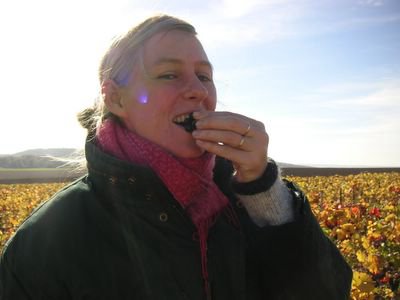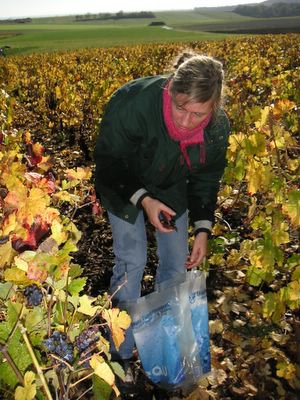
Fully ripe Pinot Meunier, and there is plenty of them.
The mild sun of October has been good for the grapes. What was still green and absolutely not eatable during the grapeharvest six weeks ago, has since early November developped a very pleasant balance between acidity and sugar.
The colour too is great. Many of our Pinot Meunier-grapes are turning black now. A colour they rarely reach more than spotwise at the time of the grapeharvest. These late grapes are also much smaller, both the berry itself and the amount of berries on each grape.
However, nobody cares. This late picking of grapes is just for the fun. We cannot sell these grapes anywhere.
Pretty useless grapes
This year our quota of grapes ware 13.000 kilos per hectare, which we had no problems to deliver. What we have been able to pick since the grapeharvest therefore is not used for anything this year.
It can be almost heartbreaking to leave such pretty healthy grapes till they rot. Or as bad, during the grapeharvest to pick pretty grapes just to throw them on the floor, where they will eventually rot too. However, that is how you deal with a surplus of grapes.
Grapeharvest twice in 2003
Only in the very special years where there is not enough grapes at the time of the grapeharvest, you may have to pick grapes again later. In practice this only happens in years, where the springfrost has killed a lot of buds, or if the vineyard has been extraordinary plagued by disease.
Back in 2003 it was necessary to harvest the late ripened grapes as it was one of those years - one out of ten - with one bad night of severe and late frost.
A late grapeharvest is done by the family and friends and friends of friends normally during one or two days of a weekend. You do not hire real grape pickers. It is too expensive and anyway not necessary since the second yield is much smaller than the first one.
All complaints fell silent
Back in 2003 there was a lot of complaining in the months after new year about the blocked stocks. Vinegrowers are farmers too, and they were unsatisfied about the decision that they were to keep a certain percentage of the yield of the year as a reserve (the reserve of the harvest in 2005 is 1.500 kilos per hectare). Stocks cost money, blocked reserves too, they occuoy room andvats and you do not get any money back on blocked grapes as long as they stay as stocks. So how would these vinegrowers ever get their money back?
As widespread springfrost during one single night destroyed between 40 and 50 percent of the potential grapes in Champagne, this complaining died out completely, probably forever.
The blocked stocks added together with the results of the two grapeharvests of the year made almost the same as the normal amount of grapes in a normal year. Without reserves it thus would not have been possible to produce as many bottles of champagne as the customors normally demand.

Last trip with the scissors in Loisy-en-Brie.
Grapes
Now when we work in the vineyard, I will cut some kilos of late grapes but only for our own use. There is a number of recipies à la vigneronne. This means a lot of grapes in the dish.
The poor vinegrowers in the Champagne of the old days ate anything they could find in their fields that was eatable, so of course grapes of the second harvest was popular too, in salads, cakes and main courses. Personally I like our little intensely tasting Pinot Meunier with small grains and easy eatable skin in a clafoutis, which is a cake with a lot of eggs and fruit.
På dansk
Copyright: The copyright for text and photos at bobler.blogspot.com belongs to Solveig Tange. You may use my articles, photos or parts of them for non-commercial use and if I am credited as the author. Feel free to link to this site but not in your own frameset please.
No comments:
Post a Comment